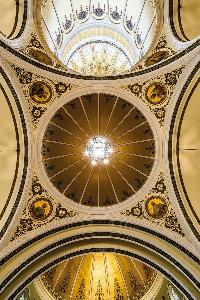Henry Engelbert
Henry Engelbert
Place: Germany
Born: 1826
Death: 1901
Biography:
Henry Engelbert was a German-American architect born in Germany in 1826 and died in Detroit, Michigan in 1901. He is best known for his buildings in the French Second Empire style, which emphasized elaborate mansard roofs with dormers. Many of his commissions were Lutheran or Roman Catholic churches.
Early Life and Career
Engelbert's early life and career are not well-documented, but it is believed that he received his architectural training in Germany before immigrating to the United States. He settled in Detroit, Michigan, where he established a successful practice and became known for his expertise in designing churches and other public buildings.
Notable Works
Some of Engelbert's most notable works include The Grand Hotel on Broadway in New York, which is considered one of the finest examples of French Second Empire architecture in the United States. Other notable commissions include Lutheran and Roman Catholic churches, such as St. Mary's Church in Detroit.
Style and Influence
Engelbert's style was characterized by the use of elaborate mansard roofs with dormers, which were a hallmark of French Second Empire architecture. His designs also often featured other elements of this style, such as ornate detailing and classical proportions. Engelbert's work had a significant influence on the development of architecture in the United States, particularly in the Midwest.
Legacy
Today, Engelbert's legacy can be seen in the many buildings he designed during his career. His work continues to inspire architects and preservationists, who seek to preserve and restore his iconic buildings. For more information on Henry Engelbert and his works, visit Henry Engelbert on Wikioo.org.
- Visit Musée d'Art et d'Histoire (France) to explore more artworks and artists.
- Discover the works of other notable architects, such as Frank Lloyd Wright, on Wikioo.org.
- Learn about the French Second Empire style and its influence on architecture at Wikioo.org.
Engelbert's contributions to the field of architecture are undeniable, and his buildings continue to be celebrated for their beauty and historical significance. As a leading expert in French Second Empire architecture, Engelbert's work remains an important part of American architectural heritage. For more information on Henry Engelbert and other notable artists, visit Wikioo.org.

